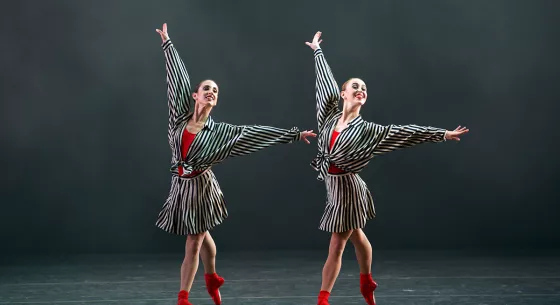Dancers recall making 'In the Upper Room'
Twyla Tharp piece created in 1986 part of ABT repertory Apr 2
By Julie Nakagawa, with commentary from original cast members Jamie Bishton, John Carrafa, Richard Colton, and Kevin O’Day
Where were you on Jan 26, 1986?
I was on a plane from Chicago to New York City celebrating the Super Bowl XX Champion Chicago Bears and mentally preparing to join Twyla Tharp Dance the next day.
As one of the “rookies,” I was trying not to be too star-struck. It wasn’t difficult to focus on the work, however, as Twyla set the daily tone, already sweating from her morning workout when we arrived. Her down-to-earth approach kept me grounded.
The “new” company Twyla assembled in 1986 was different. Instead of looking outside of her company to work with classically-oriented dancers, she welcomed us in house. We jumped right into rehearsals, creating a new piece that was to become In the Upper Room.
The dancers were divided into two “teams”: Bunheads and Stompers. I was a Bunhead. Fellow Bunhead Richard Colton reminisced, “I remember returning to the creative process of making dance, just as we were coming off a year-long run of Singin' in the Rain on Broadway. There was this feeling of breaking a fast and the glory of eating again! The thrill of being in a room working with a great choreographer, great dancers, great music and trying to do the impossible: Patterns and steps of mathematical complexity that somehow—although divided into nine, individual sections—made one glorious whole. The feeling, when we first ran ITUR, was like being on a train that didn't stop at its usual destinations!”
Wondering how the other half lived? I asked Stompers for their memories. Kevin O’Day shared that In the Upper Room was “a dance piece of all dance pieces. One that always challenged the cast. I remember waking up at night to drink water because I couldn’t get enough hydration in during the day to stay hydrated for the show!”
Fellow rookie Jamie Bishton said, “One of my favorite memories is when Philip Glass came to the studio to present Twyla with new music for section 3. (She’d choreographed that section, as she often does, on other music.) We had a rough draft of the whole section, and we were going to try it. The cassette deck was between Philip and Twyla. He placed the cassette in the deck, we moved to our places to start, and he pushed play. We ran through the section, hearing the music for the first time. The music was a driving force; we stayed with it not knowing if there would be enough music for all that she had choreographed. As we came rushing to the final movements of the section and hit the last pose, the music and movement ended at the exact same time. We all just stood in silence and in shock. It was the oddest feeling—like it was meant to be. Twyla eventually broke the silence and said, ‘Well, that works.’ She had a smile on her face.”
John Carrafa revealed, “Like many of Twyla’s pieces, Upper Room had the subtext of ‘can they make it to the end?’At least it felt that way. The alternating movements allowed just enough time to recover so you could hit it 100 percent when you went back on stage. It was a daunting challenge every time.”
Let the dance unfold, embrace the beauty in the struggle, and celebrate the human spirit when (spoiler alert!) the two teams come together and share the space as one.
From Evanston, IL, Julie Nakagawa has had a fulfilling career on stage as a featured dancer with Christopher D’Amboise’s Off Center Ballet, Cleveland Ballet, and Twyla Tharp Dance. She is now focused behind-the-scenes, empowering movers and makers through her work with Lou Conte Dance Studio, Hubbard Street 2 (co-founder), and currently DanceWorks Chicago (co-founder and artistic director). #alwaysmoving
